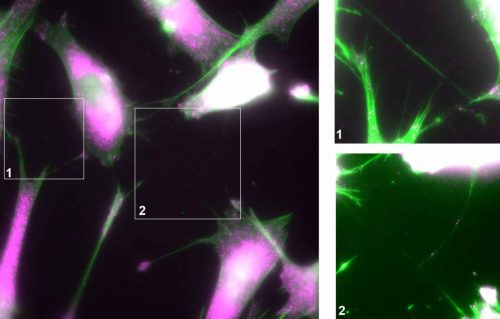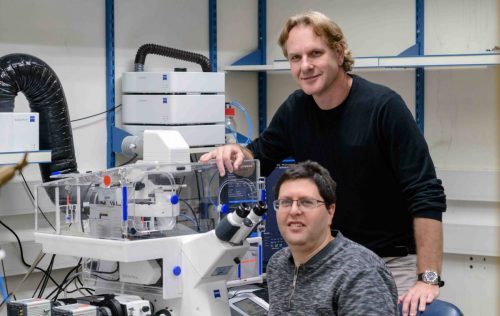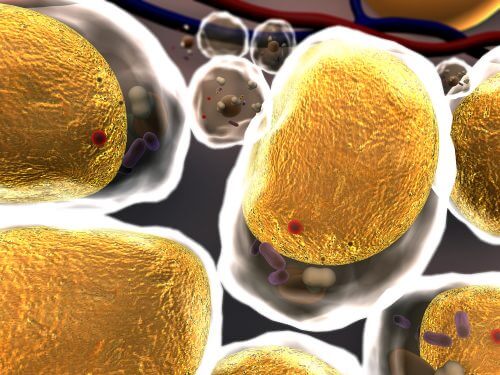Weizmann Institute of Science scientists have discovered that complete molecules of messenger RNA can pass from cell to cell using nanotubes

When choosing between boarding the plane via a bridge ("sleeve") and waiting for the bus - it seems that the preferred option is clear. Although it is a fast and convenient transition, boarding bridges only came into use in the 60s of the last century, and in Israel this happened only in 2004. A series of discoveries from the last few years revealed that cells can also transport charges using "sleeves" - tiny tubes that are sent from the cell membrane and connect to the neighboring cell membrane. The mysterious network of tubes was awarded the title "the Internet of cells" in the scientific journal Nature. Scientists at the Weizmann Institute of Science recently contributed to deciphering the mystery, and showed that the tubules can transmit genetic information that may immediately affect the function of neighboring cells.
Cells have many ways to communicate with each other, and this is an essential ability for the development and functioning of multicellular organisms. Many researchers are currently delving into one of them: the secretion of bubbles carrying molecular messages, similar to those "shuttles" at the airport. In recent years, it was discovered that the bubbles may also contain genetic information - different types of RNA molecules. Unlike other molecular relays, the passage of messenger RNA molecules can not only transmit signals to other cells, but even actually change them, since these molecules transfer the recipe for protein production from DNA to the "cellular machinery" for building proteins. However, the genetic cargo discovered in the bubbles was usually composed of relatively small molecules, such as microRNA or fragments of messenger RNA, rather than the "complete recipe" for protein production. In the current study, led by post-doctoral researcher Dr. Gal Chaimovitz from the laboratory of Prof. Jeffrey Gerst in the Department of Molecular Genetics, the passage of complete messenger RNA molecules that moved to neighboring cells, but not in "buses", was documented for the first time , because in "sleeves". The findings were recently published in the scientific journal Proceedings of the American Academy of Sciences (PNAS).
Almost all research in this field focused on biochemical methods and RNA sequencing, but we wanted to 'see with our eyes' the communication between the cells"/

"In the beginning, we did not know the nanotubes, but we were interested in the passage of RNA between cells," says Dr. Chaimovitz, who started the research in the United States, in the laboratory of Prof. Robert Singer of the Albert Einstein College of Medicine in New York York "Almost all the research in this field focused on biochemical methods and RNA sequencing, but we wanted to 'see with our eyes' the communication between the cells, that is, to examine the passage of molecules through imaging." To this end, Dr. Chaimovitz created a co-culture of two types of cells: in the first type, messenger RNA molecules that were not present in the second type were marked, using fluorescence in-culture hybridization (FISH). "We didn't know what to expect, but already in the first culture we were surprised to discover within a short time, about half an hour, a transition of whole molecules. It was possible to actually count how many molecules pass through, something that is very difficult to do in RNA sequencing because of the tiny amount." The findings were repeated both in co-culture of mouse cells with mouse cells, and in cultures of mouse cells with human cells.
But how did the molecules move? "We understood that it was not about communication through bubbles, because when we created a separation between the two types of cells in the culture, we discovered that without direct contact there is no transfer of molecules," recalls Dr. Chaimovitz. "We looked for answers in the literature to understand what mechanism it is, and we came to studies on nanotubes." Later, Dr. Chaimovitz also located the tubes in imaging. To make sure that his eyes were not deceiving him, he used a substance to inhibit the formation of the tubules, and saw that the passage of the molecules stopped accordingly.
The discovery of the network of hidden threads excites the scientific community, as it greatly changes the accepted concept regarding the essence of a cell, and how separate it is from other cells. Some scientists even rushed to claim that this is a phenomenon that occurs only in laboratory conditions. However, since then evidence of this has also been discovered in a living body. "The big questions now are, does the transfer of messenger RNA also occur in the body, and if so, to what extent and for what uses?" says Prof. Gerst. "It is possible to assume that such a mechanism can be used in the development process, for example to coordinate between cells in the differentiation process. It is also known that cancer cells can 'recruit' healthy cells to support them, and it is possible that they influence them through this mechanism." The continuation of the research may also open the door to new therapeutic approaches in which the transfer of genetic information through cells migrating in the body will be used for healing purposes.
An entire messenger RNA molecule consists of an average of 1,000 nitrogenous bases, compared to about 20 nitrogenous bases in a microRNA molecule.
#Science_Numbers


One response
A principled comment on the sentence "the passage of messenger RNA molecules can not only transmit signals to other cells, but even change them in practice,":
Reception of signals by a living being actually changes it.
After reading the article or even this comment - you will not be what you were before.
At the same time - the reception of the signals by the living creature is not a one-sided act dictated by the transmitter of the signals or by the receiver of the signals - it is an interactive process. This means that you can reject the idea and/or forget it and thus remain what you were before.
What did you choose?